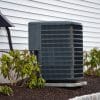Keeping your air conditioning system isn’t just about keeping the air cool, it’s also about keeping it clean and efficient.
A clogged ac drain line can cause a whole bunch of problems from water damage to mould growth.
To clean your ac drain line, turn off the unit first then use a wet vacuum to remove any blockages. Flush the line with a mix of warm water and white vinegar to clear out debris and prevent future buildup. Regular maintenance will keep your air conditioning system running smoothly and avoid major problems.
In this article, Orzech Heating & Cooling will show you how to clear your AC’s drain line with the right approach.
Safety Precautions
Before beginning any work on your air conditioning system, ensure the power is completely disconnected at the breaker, not just at the unit. This step is crucial for avoiding electric shock and ensuring your safety throughout the cleaning process. We recommend hiring a technician to help if you are not experienced with AC systems.
Quick Steps to Clean Your AC Drain Line
1. Turn Off Your AC Unit
Before you start the process, always turn off your ac unit. This is for your safety and the process to work properly. Disconnect the power from the indoor unit to avoid any electric shock.
2. Locate the AC Drain Line
The AC drain line is usually located near your indoor unit, attached to the evaporator coil. It’s a PVC pipe running from the unit to either a pump or floor drain. This is your entry point for the cleaning process.
3. Check for Visible Clogs
Check the drain line and the condensate drain pan for any visible signs of blockages or water standing. If you smell mould or water around the air handler, these could be signs of a clogged drain line.
4. Use a Wet Vacuum to Remove the Clog
A wet vacuum is an effective tool for clearing debris from the clogged condensate drain line. To ensure it works properly, create a tight seal around the connection where the vacuum hose meets the drain line using duct tape or a cloth. For more stubborn clogs, you can switch the vacuum to blow air into the drain line first before switching back to suction. Let the wet vacuum run for a few minutes to fully clear the debris.
5. Flush the Line with a Vinegar Solution
After clearing the drain line, prevent future blockages by flushing it with a vinegar solution. Pour a mix of warm water and white vinegar down the line. For more stubborn buildups, consider using a concentrated commercial solution designed for AC maintenance. These solutions are more potent and can more effectively break down debris in the line.
Preventative Measures to Keep Your AC Drain Line Clear
1. Regularly Flush the Line with Vinegar
Preventative measures like flushing your condensate drain line with a vinegar solution every few months can prevent clogs. Pour a cup of white vinegar down the drain line to prevent mould growth and clear out small debris.
2. Frequency of Maintenance
Regular maintenance is key to keeping your AC drain line clear. Aim to flush the line every 3-6 months, especially if you live in a humid climate where your air conditioner is in frequent use. Regular attention will help prevent clogs and keep your system running smoothly.
3. Checking the Entire Drainage System
Beyond just the drain line, periodically check the entire drainage system. Ensure the exterior drainage pipe is free of obstructions like leaves or debris, as a blockage outside can cause issues inside your home as well. Keeping the entire system clear ensures optimal performance and reduces the risk of water damage.
4. Replace Air Filters Regularly
Clogged air filters can overwork your air conditioner and cause blockages in the drain line. Replacing air filters regularly will reduce the risk of debris buildup and keep your air conditioning system running smoothly.
5. Using a Bleach Solution
For a deeper clean, consider using a bleach solution once a year instead of vinegar. However, be cautious, as bleach can be corrosive to certain materials in your HVAC system. If you choose to use bleach, consult with your HVAC technician to ensure it’s safe for your specific system.
Signs Your AC Drain Line Needs Cleaning
1. Water Leaks Around the Unit
Water leaking from your indoor unit is a clear sign of a clogged drain line. The condensate pan is overflowing because of blockage and if not addressed, this can cause water damage.
2. Musty or Moldy Smell
A mouldy smell from your air conditioning system could mean that the drain line is clogged with enough buildup to cause mould growth. This is not only yucky but also a health risk.
4. When to Call a Professional
1. Persistent Clogs
If you find your air conditioner drain line is still clogging up despite your efforts, it’s time to call a pro. Persistent blockages could mean there’s a deeper issue in your HVAC system that needs professional help.
2. Potential Damage to the System
Cleaning can sometimes damage the system especially if you have a more complex system. If you’re unsure about any part of the process, it’s better to consult with an HVAC expert.
3. Complex HVAC Systems
Some HVAC systems are more complicated than others with drain lines that are hard to reach. If you have this type of system, it’s best to leave the cleaning to a pro who can do the job without causing damage.
Conclusion
Cleaning your ac drain line is crucial to your system’s performance. Cleaning and prevention will help you avoid future clogs, standing water, buildups and costly AC repairs. Follow the steps above and your AC system will run smoothly keeping your home comfortable and safe.
FAQs
1. How does the AC condensate drain line work?
The AC condensate drain line removes moisture from your AC. Keep it flowing freely to prevent clogs, mould growth and other serious problems that can affect how your air conditioner works.
2. What can I do to prevent clogs in most drain lines?
Clean the AC drain pan regularly, use distilled vinegar in the condensate line and inspect the AC unit. Replacing the paper filter and using prevention like cleaning the whole system will prevent future clogs.
3. How do I clean evaporator coils and other parts of the system?
Turn off your AC, then use a soft brush and hot water with dish soap to clean the evaporator coils. Wear gloves and use a garden hose to clear debris, make sure to clean properly without damaging the system.
4. What should I do if I find mould growth in my AC system?
Clean the mould with hot water and dish soap. Use distilled vinegar in the ac drain lines as a prevention to avoid future mould growth.
5. Why is regular maintenance of the AC drain pan and condensate line important?
Regular cleaning of the AC drain pan and condensate line is crucial to prevent clogs, and mold growth, and ensure your air conditioning system functions efficiently.




